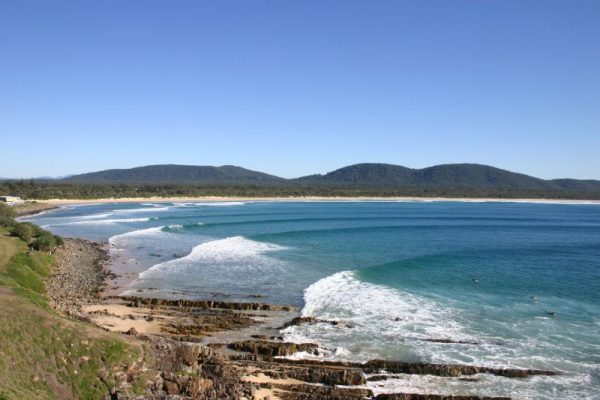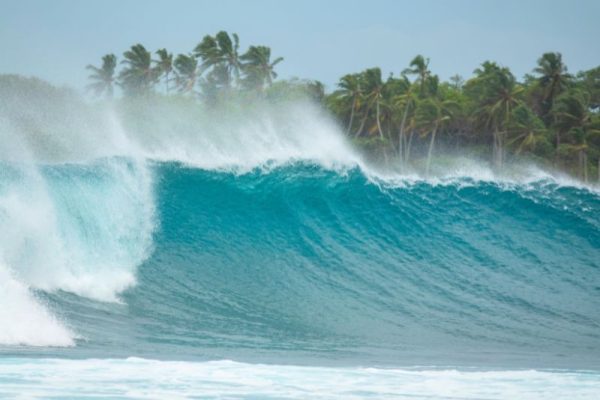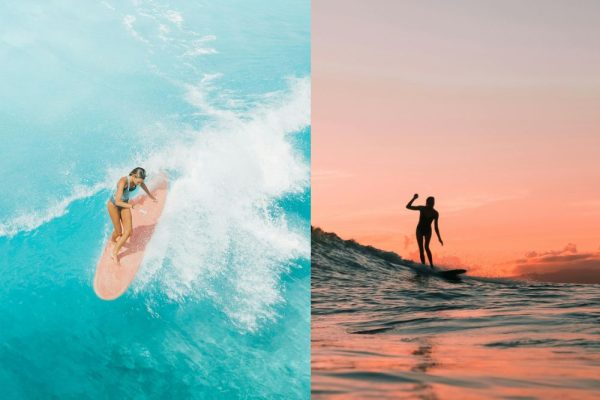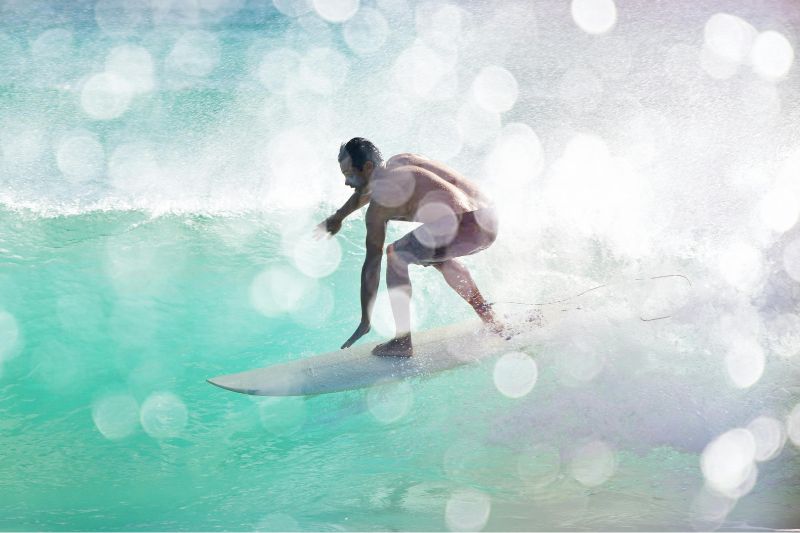Learning to read the surf forecast is something that all surfers can benefit from learning how to do. Specifically for digital nomad surfers, reading and understanding the surf forecast is an essential part of maximizing surf time while balancing work schedules.
This guide will help break down key forecast elements and provide you with actionable tips for finding the best waves wherever you go. Let’s get into it:
The Basics of Surf Forecasts
Think of a surf forecast like your remote work Wi-Fi connection—it tells you if the conditions are epic or if you’re about to waste an hour refreshing. It breaks down key components that combine to create the surf. These are generally composed of swell, period, wind, and tide – all of which combine to create either ideal surf that you block out work for, or undesirable conditions that are better for scheduling meetings.
Usually, these forecasts can be found on websites or applications such as Windy, Surfline, and WindGuru (to name a few).
Sometimes, a forecast can work well for a specific wave, and less well for others. Because of this, it is also important to check multiple forecasts to increase reliability.
Don’t be afraid to experiment with new forecasting tools, as well as check with the locals on what they use for forecasting waves in the area, as they are the ones who would know best!
Understanding Swell Direction & Size

The first component to understand is swell size. This refers to the height of open ocean waves before they break. It is typically measured in feet or meters. In most parts of the world, the size directly refers to the height of the face of a wave (crest to trough), however in Hawaii, their parameters are read as half of the actual size. Thus, a 4 foot swell in most parts of the world would be written as a 2 foot swell (approximately) in Hawaii.
Swell size coupled with swell direction, helps determine the size of waves that will hit a surf break over a period of time.
Swell direction is thus, the angle at which the swell is travelling towards the coast. This is an important element that often gets overlooked. Understanding swell direction will help you determine which spots will work better, how they will break, and which places may not receive the full force of the swell.
It is always important to research beforehand the impact of swell direction and swell size on different spots when travelling as a digital nomad surfer — this will help you read forecasts more accurately. For example, some places like the Mentawai Islands have waves that are largely affected by swell direction (due to their many scattered islands and varying reef formations), whilst other waves like those in Bali will light up regardless of the difference in degrees as long as there is swell. However, as a general rule of thumb, it is always helpful to remember that a wave breaks best if it is peeling. This means that if you’re facing south while looking at a right-breaking wave, the ideal swell direction for that spot would come from the southwest.
The Importance of Wave Period: The Secret to Predicting Powerful Surf
The next component of surf forecast reading is the wave period. As a surfer working remotely, understanding wave period is just as important as understanding swell size and direction, and will be extremely beneficial for planning your time to get the best surf sessions possible.
Wave period refers to the time (in seconds) between each wave of a set, and plays a huge role in determining wave power and quality. Generally, a larger wave period will mean cleaner and more powerful waves and surf. This is because the waves have travelled a farther distance across the ocean, giving it more time to build energy and refine its shape. A shorter wave period generally means weaker surf, such as a fragile wind swell compared to a strong ground swell.
When it comes to planning your surf adventures, it also helps to understand how wave period can affect different kinds of surf breaks. For example, shorter period swells (under 10 seconds) will work better at sandy bottom beach breaks, whilst medium period swells (11 to 15 seconds) are preferred by point breaks. Reef breaks, on the other hand, produce better rides and handle long period swells (16+ seconds) more effectively.
When you combine wave period with swell size, you can start to picture the scale and quality of the set waves at your chosen surf break. Understanding these elements will ensure you’re at the right place at the right time, and successfully balance surf sessions, remote work, and travel.
Wind Conditions: Offshore vs. Onshore

One of the most important aspects of understanding the surf forecast is wind conditions and effects — The direction and strength of wind can make or break a swell.
Put simply, there are three ways to reference wind — onshore, offshore, and glassy conditions. Onshore wind means wind coming from the same direction as the wave. A strong onshore wind will usually make waves crumbly, fast, and choppy. Onshore wind is not what you want to be surfing if you have the choice!
Offshore wind is generally more desirable. This means wind that blows against the face of a breaking wave, causing it to hold up barrels, and create clean shoulders, perfect for ripping and riding. However, glassy conditions are the most ideal. This is what we call the ocean when there is little to no wind — clear and calm as glass.
Furthermore, some places in the world experience seasonal trade winds. A top remote surfing hub like Bali is a prime example of this. Here, April to September sees winds coming from the East, meaning onshore conditions in Sanur, Nusa Dua, and Keramas, and offshore conditions on the west coast (Uluwatu, Canggu, Kuta). Between October and May, the opposite occurs, and the offshore conditions take place on the East coast. Being aware of these seasonal changes in wind can help you plan your movements as you travel and work online.
Tides and Their Impact on Surfing
Different spots work better on different tides. This is generally a part of the local knowledge, could be discovered through research online, or through experiencing it yourself. There can be major differences in wave shape and quality depending on whether the tide is high, mid, low, rising, or falling.
If you’re a beginner, it’s best to time your in-between-meeting-surfs with the higher tide as the waves will generally be fatter, thus slower and more mellow. Also, hitting the bottom will be less of a factor during high tide (although if you are at a beach break where touching the bottom isn’t a concern, low tide can produce longer whitewash to practice in).
Contrastingly, if you’re after barrels and hollower waves, surfing on the lower tide will generally provide you with a higher chance of getting that tube vision.
Forecasting Strategies for Digital Nomads

Now that you understand the key components of surf forecasting, here are a few strategies and tips for you to get the most accurate prediction.
- Cross reference multiple forecasts: Depending on which remote surfing haven you are in, certain forecasts can be more accurate than others, and sometimes it is essential to check multiple sources to determine an average.
- Cross-check cameras and reports: Observe real-time conditions in parallel with surf forecasts to understand how to interpret the readings. Often, forecasts can be slightly off center, so understanding how their predictions apply to reality can give you an extra edge to catching the best surf sessions throughout your work week.
- Understand seasonal surf patterns: Whether you’re after heavy barrels, big waves, or mellow rides, there is always a better time of year to surf depending on your wave preference and experience. If you’re planning to get tubed in between online work sessions, considering this aspect before choosing to visit your next digital nomad surf town is key.
- Observe peak surfing hours: Trying to get as many good waves as possible comes hand in hand with trying to avoid busy line ups. Taking advantage of the right conditions at sunrise, sunset, or during lunch hours (there are usually smaller crowds at these times) can be extremely beneficial when planning surf sessions as a digital nomad.
Common Mistakes & How to Avoid Them
Predicting waves accurately can be a tricky endeavour. Often, people will rely on reading wave size alone without considering swell direction, period, and the wind. Though you can sometimes get away with it, it is more practical to be as thorough and accurate as possible when reading the forecast. By doing this, you can avoid feeling as though you are wasting time paddling about in a flat ocean when instead you could be working.
Another common mistake is ignoring local knowledge. The local surfers will likely know the wave better than you, and the best conditions to surf it in. If you want to be successful in catching waves and planning the best time to do so, listen to the wisdom of the locals!
Conclusion: Forecast Like a Pro, Surf Like a Nomad
Sometimes you will make mistakes and find yourself looking at tiny waves on the beach when you thought a big swell was going to be arriving. Don’t worry, we’ve all done this! It’s all a part of the learning process of reading surf forecasts. The more practice you have with it, and the more detail oriented you are, the more likely you will be able to predict swells and plan your online work schedule around epic surf adventures.
By mastering surf forecasts, you’ll spend less time chasing the wrong waves and more time scoring the perfect sessions, giving you the freedom to structure your work-life balance around the best surf, not just your deadlines!
For more tips for living the surfing digital nomad lifestyle, become part of the Ocean Nomads Tribe by subscribing to get the latest articles, checking out our other blogs, and following us on Instagram.



